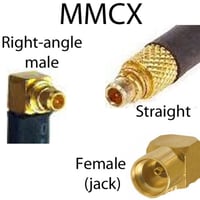FME Extension Cable: 10FT, 15FT, 25FT, 30FT, 35FT FME-Male to Female
- Availability:
- In stock
- Weight:
- 0.30 LBS
Data Alliance
FME Female to Male Cable
- Other lengths of FME extension cables (Male to female)
- Other types of FME to FME cables
- Other FME cables & adapters
- "Related Products" tab includes other lengths of this same cable, and other cables with FME connectors.
- Data Alliance's high-quality soldered terminations of FME connectors with soldering provide a low-loss connection with discontinuities kept to a minimum.
FME cables are typically used for cellular-phone and data-card amplifiers & antennas.
- Connectors are precision machined in ISO 9001 facilities, and nickel-plated for low loss.
- Lead-free and ROHS compliant: The entire product is ROHS compliant (connectors and cable).
- Impedance: 50 Ohms.
We offer two coax types that are both double-shielded for low signal-loss, very flexible/easily bendable, outdoor rated, while also suitable for indoor use. Both coax types have a black PVC jacket:
- LMR100: The 3-ft (1-meter) version is LMR100, which has less attenuation (signal loss) than RG174. The double-shielding is a major factor in the higher quality of this cable, translates into lower loss/better performance. Cable is equivalent to LMR-100 in thickness. This cable is rated for outdoor use and is also suitable for indoor use.
- LMR200: Double the thickness of LMR100, for much less attenuation (signal loss) than LMR100 or RG58. The higher quality of the cable translates into lower loss/better performance. The cable lengths 10FT or more are LMR200.

The temperature range for operational use of these cable assemblies are as follows:
- Cables with 100-series coax: -22 F ~ +185 F (-30 C ~ +85 C)
- Cables with 200-series coax: -31 F ~ +203 F (-35 C ~ +95 C)
For Mobile Equipment is a miniature 50 Ohm RF connector with excellent performance from DC to 2.0 GHz. FME is primarily used with RG-58 or equivalent coaxial cables employed in mobile applications and installations. FME female's narrow, cone-like shape allows FME cables to be snaked through the often tight access holes or spaces of a vehicle to the desired equipment location(s) where an FME male adapter to the required equipment connector series is fitted to the female cable connector.
FME to FME cables
FME to FME cable assemblies include:
- Male-to-male cables
- Male-to-female FME extension cables
- Female-to-female FME cables
- FME to SMA cables: the SMA connector is a sub-miniature RF connector that is used widely in cellular networking applications.
- FME to RP-SMA cables: the RP-SMA connector, a reversed polarity version of the SMA connector is used widely in Wi-Fi networking.
- FME to TNC cables: the TNC connector is a threaded miniature RF connector that is used widely in wireless networking applications.
- FME to N connector cables: the N connector is a rugged, weatherproof medium-sized RF connector that is routinely used for outdoor antenna installations.
FME cables are a practical and versatile cable assembly for environments that require performance with mobility. You can route and use these versatile selection cables and adapters in a range of indoor and outdoor environments thanks to the reliability and durability of this hard wearing miniature connector.
Coaxial cable types used in FME cable assemblies
FME cables are assembled using a smaller diameter flexible coaxial cable that allows the connector and cable to be naked through tight spaces led by the narrow FME jack. Here are the main cable types used in FME cables:
LMR 100
LMR 100 is an extremely low-loss, double-shielded cable that is known for its superior quality, flexibility, and performance. Though it has a diameter of 2.79 millimeters (0.11 inches), equivalent to RG 174, it has lower losses because it is double shielded. LMR 100 has an aluminum foil layer and braided shield.
The impedance of LMR 100 is 63 GHz with shielding effectiveness greater than 90 decibels. It is highly flexible and has a minimum bend radius of 6.4mm (0.25 inches).
LMR 200
LMR 200 is a larger diameter version of LMR 100 that is also low-loss and flexible and suitable for outdoor use. It has an overall diameter of 4.95 millimeters (1.95 inches) with double shielding. LMR 200 also has an expansile foam dielectric to increase its flexibility.
RG 58
RG 58 is commonly used in FME cable assemblies. It often has slight variances in physical specs between manufacturers but is a 50-Ohm impedance cable with a diameter of 4.95 millimeters (0.195 inches). Its center conductor is either solid or stranded and the cable has a single layer of tinned copper braided shield. The minimum bend radius of G 58 is 24.89 millimeters (0.98 inches). Low-loss versions of RG 58 have an additional aluminum foil layer that can achieve 90dB shielding effectiveness and a velocity of propagation of 80 percent. Its maximum frequency is 5 GHz.
RG 174
RG 174 had a diameter of 2.79 millimeters (0.11 inches). It is highly flexible with a bend radius of 9.9 millimeters (0.393 inches) due to its 7-stranded inner conductor and a single shield layer. of shielding. The impedance of RG 174 is 50 Ohms and it has a frequency limit of 1 GHz.











